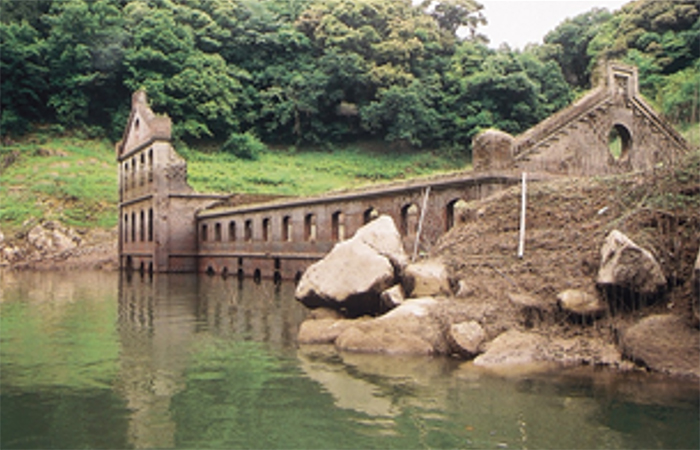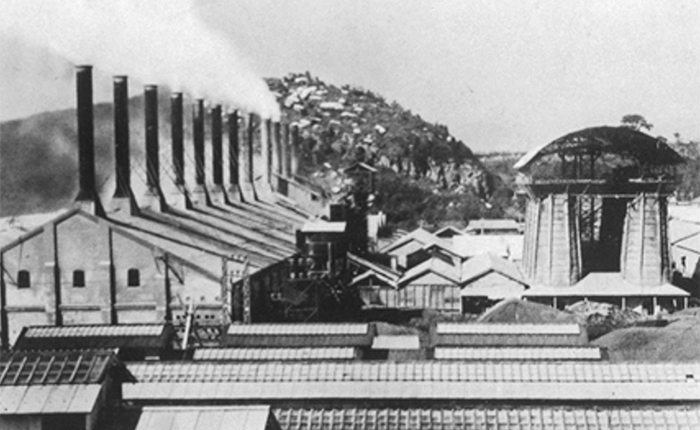The Sogi Electric Company Is Founded
In January 1906, Noguchi took his first step as an entrepreneur by founding the Sogi Electric Company in the village of Okuchi in Kagoshima Prefecture. This was his first step as a pioneer in the chemical industry of Japan, and great developments not only in Japan but also on the Korean peninsula.
Noguchi wanted to realize his dreams as an entrepreneur. Founding the Sogi Electric Company was his first step to do so. Noguchi wanted to make this company successful by using what he had learned up until this point.
Although the plant only made 800kW, it was more than enough for the nearby gold mine and neighboring towns and villages, so power was sent all the way to Minamata. Thanks to this power plant, lights were electrified in the homes of mountain villages and towns in the area.
Noguchi felt a sense of joy and pride, and realized that this was the kind of work he had to dedicate his life to.
 The Sogi power plant at the time
The Sogi power plant at the time
 The remains of the Sogi power plant, now submerged in the lake of a downstream
The remains of the Sogi power plant, now submerged in the lake of a downstream
dam, appearing only in summer when the water is low (photo courtesy of Okuchi
City, Kagoshima Prefecture)
Nippon Carbide Company is Founded
Noguchi then founded Nippon Carbide Company in 1908 and built a calcium carbide production plant in the village of Minamata in Kumamoto Prefecture. Noguchi became interested in calcium carbide when he worked at the Koriyama Lighting Company, and he studied lime while working at Siemens. He did experiments with calcium carbide at home, which produced terrible odors.
His younger brother said, “Now I realize that the odors came from calcium carbide, which was the predecessor to calcium cyanamide that would form the foundation of my brother’s businesses.”
 Minamata calcium carbide plant
Minamata calcium carbide plant
Patent Licensed for the Production of Calcium Cyanamide
Production of calcium carbide began at the Minamata plant, but they were unable to obtain high quality as hoped for.
Then Noguchi got an excellent opportunity to develop a new field of business. In 1906, Adolph Frank and Nikodem Caro of Germany invented a process to produce calcium cyanamide, a kind of nitrogenous fertilizer, by using calcium carbide to adsorb nitrogen from the air. This was a revolutionary invention because nitrogen plays an essential role as one of the three major nutrients required by plants to grow.
Noguchi knew that the rights to the patent would allow his business to develop. The clarity of his foresight was truly astounding. But where exactly did this foresight and decisiveness come from? It seems that his inspiration as a scientist and his struggles with research on calcium carbide were what underpinned his foresight and decisiveness.
It was a very risky idea to invest a large amount of money in a business based on a new invention without general knowledge of the chemical industry or even knowing much about calcium cyanamide itself. Nevertheless, Noguchi went to Germany without hesitation, determined to obtain a license to the patent. He managed to license the patent, which had already been licensed to Italy, with the help of Siemens. He was already displaying the skills of a great entrepreneur at this time.
Actually, there was another company in Japan which wanted to license the patent, the giant conglomerate Mitsui. Noguchi persuaded the inventors by saying, “Mitsui has lots of money, I have little. But I have experience handling calcium carbide. Even if Mitsui gets the patent, they still have to build a power plant. Mitsui will just license the patent and let it die. If you want money, go to Mitsui. If you want to see the idea flourish, leave it to me.” He succeeded in obtaining a license to the patent.
When rumors of licensing this patent spread, people were surprised at the idea of making fertilizer by taking nitrogen from the air. In August 1908, Noguchi merged Nippon Carbide Company, changed the name to Nippon Cisso Hiryo K.K., and began production of calcium carbide and calcium cyanamide.
After Nippon Cisso Hiryo K.K. was established, management of the company was difficult beyond words. In January 1909, construction of the Minamata calcium cyanamide plant was completed, and they managed to produce calcium cyanamide. But although the product was supposed to contain 18% nitrogen, it only contained 10%. Production volume was also lower than expected. Noguchi was concerned about the purity of the nitrogen contained in the calcium cyanamide, in order to earn the trust of farmers.
Calcium cyanamide was a new fertilizer in Japan, and no one had heard of it or knew how to use it. Applying it to crops directly like soybean meal or fertilizers made from fish risked making the crops wither. It was not easy to get farmers to use it widely like a normal fertilizer. Furthermore, even the people selling this fertilizer lacked ample knowledge about it. The challenge was to produce calcium cyanamide fertilizers that were easy for farmers to use without making crops wither.
Noguchi poured his heart into research from the viewpoint of those using the fertilizer. He found that it was better to convert the calcium cyanamide into ammonium sulfate. He then built a plant in Osaka. But the poor quality of the calcium cyanamide was a serious problem, and production did not go well.
Noguchi then brought in calcium cyanamide produced by another company to his own Minamata plant and focused on improving the production method. He expressed his determination at the time as follows. “This is my last chance to fix this business. If I fail, I’ll go to America and start washing dishes.”


